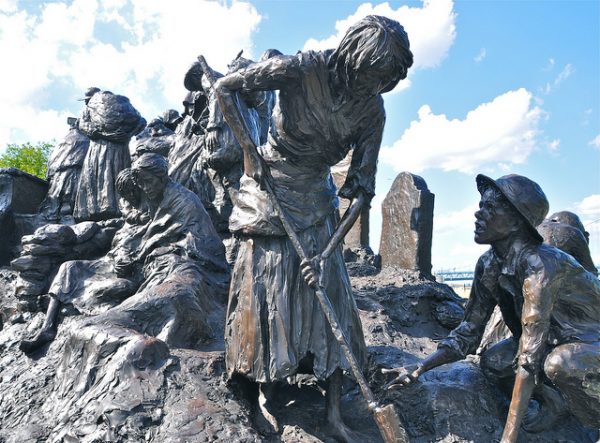Happy St. Patrick’s Day! As you top one off down at the pub, here’s a round on the house about how the Irish became white in the United States.
Irish presence in America greatly expanded following increased emigration in the mid-to-late 19th century. The journey from Ireland was arduous and dangerous, but their welcome on arrival was worse. Various political and social organizations espoused prejudiced, bigoted views towards Irish immigrants their families; frequent metaphors included comparing the Irish to animals or vermin. Scholars have described how Irish groups in America resisted hatred and discrimination and took steps to combat discrimination both in the job market and everyday culture. As the sources below describe, the Irish actively overcame and struggled against oppression, and civil society organizations and community engagement helped the Irish to eventually be seen as part of the racial category “White” in America.
- David R. Roediger. 1999. The Wages of Whiteness: Race and the Making of the American Working Class. Verso Books.
- Noel Ignatiev. 1995. How the Irish Became White. Routledge.
- M. Alison Kibler. 2015. Censoring Racial Ridicule: Irish, Jewish, and African American Struggles Over Race and Representation. University of North Carolina Press.
This story of becoming white applies not only to the Irish, but also to Italians, Poles, and virtually any other European group once framed as outsiders by America’s paradigm of “whiteness” in the 18th and 19th centuries. Over time, these groups’ cultural identities didn’t disappear; instead they became symbolic and strategic expressions of identity that no longer bore these oppressive stigmas.
- Mary Waters. 1990. Ethnic Options: Choosing Identities in America. University of California Press.
- Richard Alba. 1990. Ethnic Identity: The Transformation of White America. Yale University Press.
- Jason Torkelson and Douglas Hartmann. 2010. “White Ethnicity in Twenty-first-century America: Findings from a New National Survey.” Ethnic and Racial Studies 33(8): 1310-1331.
Following work by civil organizations and resulting changes in dominant cultural practices, the racial paradigm has expanded to incorporate some groups into the label of white, but not all. Non-European groups’ stories contrasted greatly with that of the Irish, spawning inequalities that still exist today.
- Rogelio Sáenz and Karen Manges Douglas. 2015. “A Call for the Racialization of Immigration Studies: On the Transition of Ethnic Immigrants to Racialized Immigrants.” Sociology of Race and Ethnicity 1(1): 166–80.
- Leo Chavez. 2008. The Latino Threat: Constructing Immigrants, Citizens, and the Nation, Second Edition. Stanford University Press.
- Vilna Bashi Trietler. 2013. The Ethnic Project: Turning Racial Fiction into Ethnic Factions. Stanford University Press.
As you finish your drink, ponder how several immigrant groups have been historically labeled as racially black, Hispanic, or Asian, instead of white. How would life be different for Irish-Americans if that had been their story?


Comments